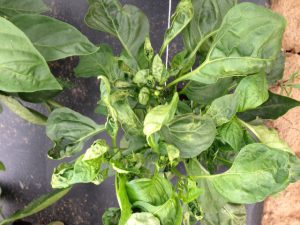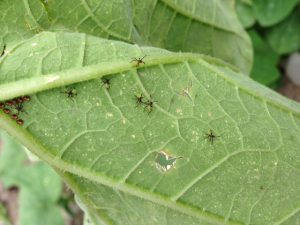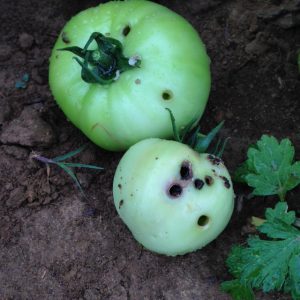Sweet Corn
European corn borer (ECB) catches remain very low, and no map will appear in this edition. Feeding in NJ sweet corn plantings is also low, with remaining larval infestations only on pre-tassel stage corn in the northern counties. Check 5 plants each in 10 random locations for a 50 plant sample. Look for “shot-hole” injury, and consider treating when the number of infested plants in a 50 plant sample exceeds 12%. As infested plants proceed to the pre-tassel stage, live larvae and damage may be found in the emerging tassels. Once plants hit full tassel, ECB larvae will move downward on the stalk and re-enter the plant near the area where ears are forming. This can result in direct injury to the ear. Growers should consider an insecticide application at the full tassel stage to target ECB larvae as they migrate downward. This application can eliminate larvae that have escaped any earlier insecticide applications.
The highest nightly ECB catches for the previous week are as follows:
| Beckett 1 | East Vineland 1 |
| Centerton 1 | Milford 1 |
| Crosswicks 1 | Port Colden 1 |
| Denville 1 | South Branch 1 |
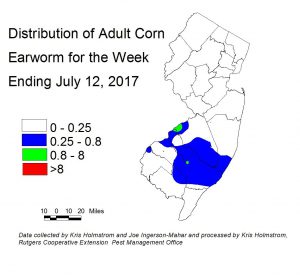 Corn earworm (CEW) moth catches increased slightly in the southern half of the state this past week. Catches should remain fairly low, or rise slowly over the next 2 weeks. However, even very low CEW catches represent a threat where sweet corn is silking. At present, the highest activity remains from Atlantic County through western Burlington County (see CEW map at left), although catches have occurred as far north as Morris County.
Corn earworm (CEW) moth catches increased slightly in the southern half of the state this past week. Catches should remain fairly low, or rise slowly over the next 2 weeks. However, even very low CEW catches represent a threat where sweet corn is silking. At present, the highest activity remains from Atlantic County through western Burlington County (see CEW map at left), although catches have occurred as far north as Morris County.
The highest nightly CEW blacklight trap catches are as follows:
| Allentown 1 | Elm 1 |
| Beckett 1 | Folsom 1 |
| Cinnaminson 1 | Pedricktown 1 |
| East Vineland 1 | Tabernacle 1 |
Southern NJ CEW pheromone trap catches have remained generally stead this past week. This more conservative network is also indicating a similar threat level to last week (see CEW pheromone map below at right). There are relatively few pheromone traps deployed compared to the number of blacklight traps in the state, resulting in much broader color bands on the pheromone map.
At present, the highest nightly pheromone trap catches are as follows: 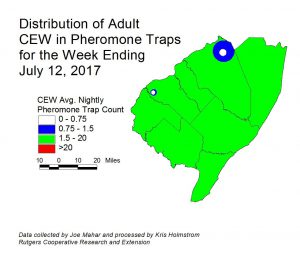
| Pole Tavern 20 | East Vineland 9 |
| Green Creek 15 | Woodstown 6 |
| Elm 11 | Berlin 4 |
| Pedricktown 10 | Jobstown 1 |
Fall Armyworm
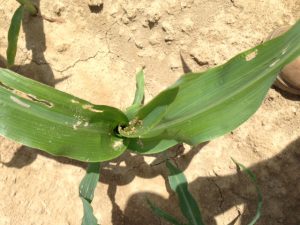 Fall armyworm (FAW) infestations in NJ have remained steady at low levels. We should expect FAW to increase in the near future. This pest favors smaller whorl stage plants, and will even infest seedling stage plants if
Fall armyworm (FAW) infestations in NJ have remained steady at low levels. We should expect FAW to increase in the near future. This pest favors smaller whorl stage plants, and will even infest seedling stage plants if the population is high. At present, infestations have been identified from Cape May and coastal Monmouth County west to the Delaware river in Camden County. This pest is capable of serious injury to plants, and scouting should commence immediately on whorl corn throughout the southern half of the state. Look for plants with “window-pane” type feeding that leads from the outer leaf surface down into the whorl (see photo at left). As larvae grow, this damage will progress to obvious ragged holes, with lots of caterpillar droppings in the whorl. The larvae are tan and brown (see photo at right), with a conspicuous upside down “Y” on the head capsule. If FAW alone or in combination with ECB are found to infest 12% or more plants in the sample, consider an insecticide treatment. FAW do not respond well to synthetic pyrethroid insecticides. In general, IRAC Group 5 materials like Radiant or Entrust (OMRI approved) or IRAC Group 28 materials like Coragen work very well on FAW and other caterpillar pests.
the population is high. At present, infestations have been identified from Cape May and coastal Monmouth County west to the Delaware river in Camden County. This pest is capable of serious injury to plants, and scouting should commence immediately on whorl corn throughout the southern half of the state. Look for plants with “window-pane” type feeding that leads from the outer leaf surface down into the whorl (see photo at left). As larvae grow, this damage will progress to obvious ragged holes, with lots of caterpillar droppings in the whorl. The larvae are tan and brown (see photo at right), with a conspicuous upside down “Y” on the head capsule. If FAW alone or in combination with ECB are found to infest 12% or more plants in the sample, consider an insecticide treatment. FAW do not respond well to synthetic pyrethroid insecticides. In general, IRAC Group 5 materials like Radiant or Entrust (OMRI approved) or IRAC Group 28 materials like Coragen work very well on FAW and other caterpillar pests.
Silking Spray Schedules*:
South – 4 days
Central – 6-7 days
North – 7 days
*These recommendations are based on regional catches.
Pepper Weevil Update
No weevils were trapped this past week. As far as known, there are no infested fields. Last year (2016) Ontario greenhouse growers had the worst infestation of pepper weevil they have ever had and this year growers are taking steps to prevent new infestations.
Brown Marmorated Stink Bug
Blacklight trap catches of the brown marmorated stink bug (BMSB) continue to be very low, and no map will appear in this addition. Regarding BMSB and our native brown stinkbugs; as nymphs progress into adults over the next few weeks, they should become more active and seek cultivated hosts. This is of increasing importance if dry weather degrades forage in areas surrounding fields. Scouting for stinkbugs in peppers requires stealth, as the bugs will retreat into the canopy if they perceive a threat. While scouting for other insects and diseases, approach each sample site slowly. Before disturbing the foliage to search for ECB eggs, aphids, etc., observe the upper canopy for the presence of stinkbugs. Often, they will bask on the upper leaves. If adults, nymphs or egg masses are found in 2 or more sites in a pepper planting, consider treating preventively to limit feeding injury to fruit. There are several insecticide options listed in the 2016-17 Commercial Vegetable Production Recommendations.
This week, one Hunterdon County pepper field developed characteristic injury from cyclamen or broad mite (see photo at left). This injury may be confused with herbicide damage, as feeding by these microscopic mites results in dramatic distortion of foliage near the growing points. If left untreated, resulting fruit will 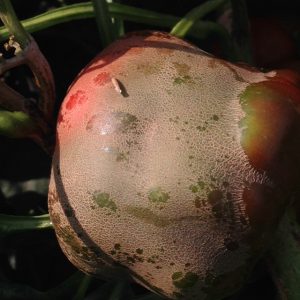 have russetted skin and be unmarketable (see photo at right). This pest cannot be seen with the without a microscope, but in its’ early stages, damage is typically on small clusters of plants. Do not wait to treat because fruit injury has likely occurred by the time foliar symptoms have been noticed. Miticides labeled for two-spotted spider mite are also effective against cyclamen/broad mite. The resumption of normal foliage on affected plants is an indication of successful treatment.
have russetted skin and be unmarketable (see photo at right). This pest cannot be seen with the without a microscope, but in its’ early stages, damage is typically on small clusters of plants. Do not wait to treat because fruit injury has likely occurred by the time foliar symptoms have been noticed. Miticides labeled for two-spotted spider mite are also effective against cyclamen/broad mite. The resumption of normal foliage on affected plants is an indication of successful treatment.
Squash bug egg masses and nymph groups are now appearing in pumpkin and winter squash plantings (see photo at left – eggs at far left). Squash bugs do not generally cause economic injury in these crops. They are capable of damaging seedlings, and thus newly emerging or transplanted cucurbit crops should be monitored for their presence, but as our pumpkins are hitting bush or vine-run stages at this time, there is little threat from these bugs. Adults look like elongated brown stinkbugs, while nymphs that are newly emerged from the copper-colored eggs are green with black legs. As the nymphs progress through two molts, they become ash gray in color.
As per Dr. Wyenandt’s Disease Alert, cucurbit downy mildew (CDM) is active on cucumber in NJ. The sentinel 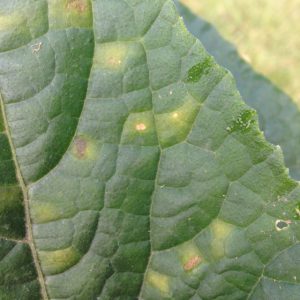 plot (see previous posts for explanation of these plots) at the Snyder Research and Extension Farm in Hunterdon County remains uninfected as of Tuesday 7/11. This is just one of a network of sentinel plots in the eastern half of North America that will contribute information to the CDM forecast (http://cdm.ipmpipe.org/). These plots are scouted weekly for the presence of CDM. If found, the disease is reported to NC State Univ., the organization managing the forecast. Affected crops are also identified. The purpose of this is to provide early warning to growers of these crops so that they may react proactively to the disease, and treat the appropriate crops. A this time, it is important for all cucurbit growers to check the above website at least weekly for updates on the movements of CDM in the eastern U.S. While the imminent threat appears to be confined to cucumber, but infections on other crops such as musk melon and butternut squash have been reported in western PA. As of 7/11/17, the CDM forecast issued by NC State had NJ at moderate-to-high risk to develop infections from regional sources. ALL cucurbit crops should be scouted for the presence of CDM, and treat all cucumber plantings preventively. CDM causes yellow lesions to develop on the upper leaf surface (see photo above at
plot (see previous posts for explanation of these plots) at the Snyder Research and Extension Farm in Hunterdon County remains uninfected as of Tuesday 7/11. This is just one of a network of sentinel plots in the eastern half of North America that will contribute information to the CDM forecast (http://cdm.ipmpipe.org/). These plots are scouted weekly for the presence of CDM. If found, the disease is reported to NC State Univ., the organization managing the forecast. Affected crops are also identified. The purpose of this is to provide early warning to growers of these crops so that they may react proactively to the disease, and treat the appropriate crops. A this time, it is important for all cucurbit growers to check the above website at least weekly for updates on the movements of CDM in the eastern U.S. While the imminent threat appears to be confined to cucumber, but infections on other crops such as musk melon and butternut squash have been reported in western PA. As of 7/11/17, the CDM forecast issued by NC State had NJ at moderate-to-high risk to develop infections from regional sources. ALL cucurbit crops should be scouted for the presence of CDM, and treat all cucumber plantings preventively. CDM causes yellow lesions to develop on the upper leaf surface (see photo above at 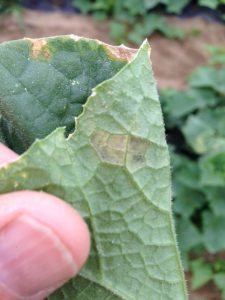 right). Lesions are confined within veins initially, but coalesce quickly to kill the entire leaf when moist conditions prevail. Beneath these lesions (lower leaf surface), dark gray spores will be produced (see lower photo at right). If discovered, please report any incidence of CDM to your county agent as soon as possible.
right). Lesions are confined within veins initially, but coalesce quickly to kill the entire leaf when moist conditions prevail. Beneath these lesions (lower leaf surface), dark gray spores will be produced (see lower photo at right). If discovered, please report any incidence of CDM to your county agent as soon as possible.
Tomatoes
Recently, tomato plantings both in high tunnels and in the field, have developed low level infestations of tomato hornworm (THW). This caterpillar is often first detected by observing the damage it causes to foliage, where it tends to strip branches of their leaflets, leaving bare stems. THW will also feed on green fruit as the caterpillars grow large enough to take large scoops of tissue out of the fruit. All recently detected larvae have been small (see photo at right), but these caterpillars will grow to about 3 inches long and can cause significant injury to individual plants. While this damage is frequently more a nuisance than an economic threat in the field, their population can become 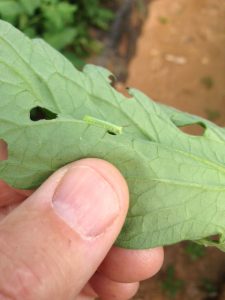 high enough to warrant treatment in the high tunnels. If characteristic feeding is appearing in multiple sites within tunnels, or under rare circumstances in the field, consider treating for THW. Spot treatments may be effective in high tunnels. There are a number of useful materials, including those in IRAC group 28 (Coragen) and IRAC group 5 (Radiant, Entrust – OMRI listed). A complete list may be found in the 2016-17 Commercial Vegetable Production Recommendations.
high enough to warrant treatment in the high tunnels. If characteristic feeding is appearing in multiple sites within tunnels, or under rare circumstances in the field, consider treating for THW. Spot treatments may be effective in high tunnels. There are a number of useful materials, including those in IRAC group 28 (Coragen) and IRAC group 5 (Radiant, Entrust – OMRI listed). A complete list may be found in the 2016-17 Commercial Vegetable Production Recommendations.
With corn earworm (CEW) season approaching, be on the lookout for fruit injury (see photo at left). This pest, when attacking tomatoes, is known as the tomato fruitworm. Typically, injured fruit will be near the upper canopy and to the outside. Larvae will bore into the shoulders of fruit. While there is abundant sweet and field corn with fresh silks in the area, this damage is usually limited. However, as we get later in the season, and corn silks are brown and less favorable for egg laying, tomato injury can increase.
